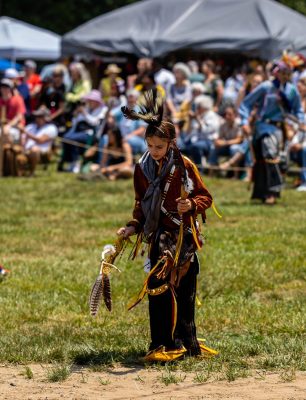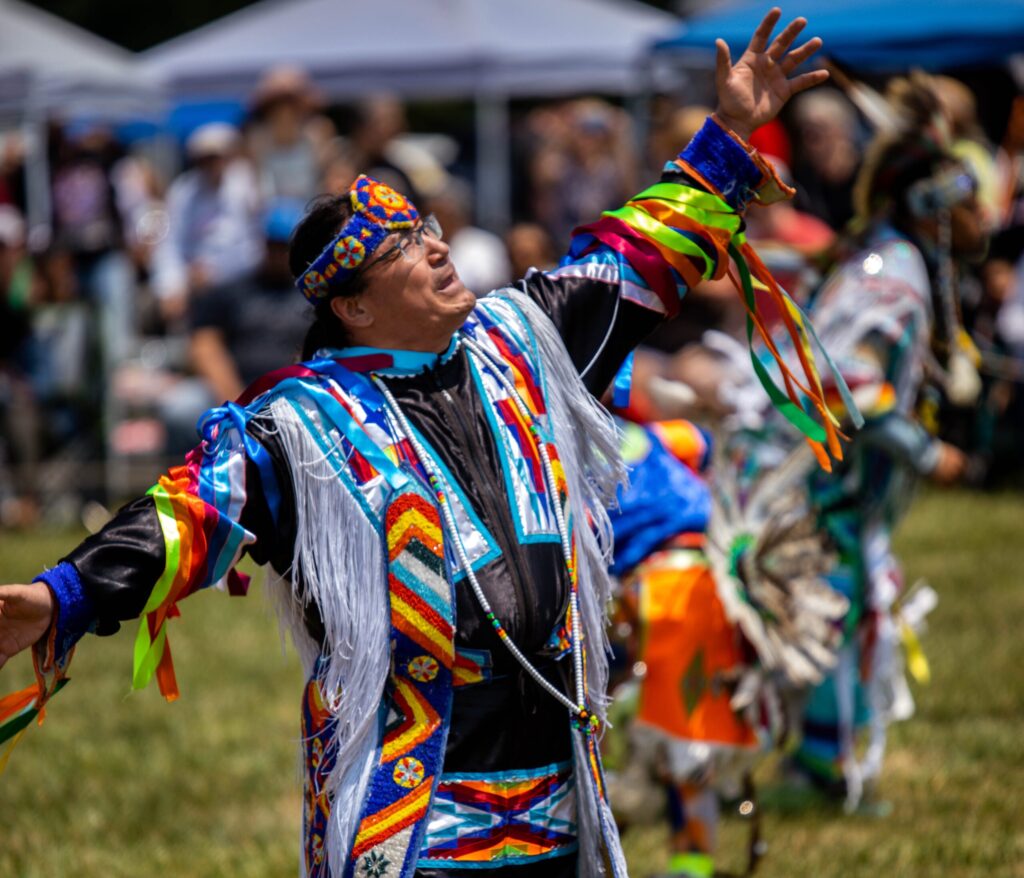The Nanticoke-Lenni Lenape Pow-Wow 2023, held at the Salem County Fairgrounds in Woodstown, NJ on June 10-11, 2023 was a vibrant celebration of community, heritage, dance, music, and cultural pride. This indigenous festival brought together nations from across the continent, offering a platform to share in celebration through singing and dancing while educating and entertaining the public. Participants, including dancers and singers, competed in various categories based on age and dance styles. The event featured Indigenous cuisine and art, with food and craft vendors showcasing their offerings.
During the afternoon, a significant portion of the observed dance had a communal nature rather than being focused on a specific style. The male dancers performed Fancy, Grass, Prairie Chicken, and Traditional dances, while the female dancers showcased Fancy, Jingle, and Traditional styles. The distinction between these dance styles largely depended on the attire and regalia worn by the dancers.

One notable highlight was the grass dancers. Their regalia differed from other pow wow styles in that it typically featured minimal or no feathers. The grass dance itself is a lively and fast-paced performance characterized by sweeping motions and symmetrical movements. Although it is generally faster than Northern Tradition or Straight style dances, it is not as rapid as the Fancy dance. To create a sense of symmetry and imitate the movement of waving grass, the grass dancer mirrors every action on one side of their body on the other side. The dance incorporates wide sweeping motions and tapping as well. While subject to interpretation, the pow-wow announcer described the movements as resembling a warrior stealthily approaching the enemy or stalking game through tall grass.

Another notable highlight was the men’s fancy dance, which stands out as one of the most vibrant and creatively distinctive pow-wow styles. Dancers don flashy regalia adorned with bright neon colors and intricate applique patterns. They perform fast-paced, aerobic movements often choreographed in a dynamic manner. The fancy dance draws loose inspiration from traditional war dances.

To grasp the significance of the Pow-Wow, it is important to understand the history of the Nanticoke-Lenni Lenape people.
The tribe’s ancestral roots in the land extend over 10,000 years. While many faced removals and forced migrations to the Midwest or Canada, the descendants of Nanticoke and Lenape present today are those who remained or returned to their ancient homeland.
The Lenape ancestors inhabited the regions of New Jersey, Delaware, southern New York, and eastern Pennsylvania when Europeans arrived. They referred to themselves as “Lenni-Lenape,” meaning “Men of Men” or “Original People.” European settlers later called them “Delaware Indians.” The Lenni-Lenape consisted of three main dialect clans, each comprising smaller interrelated communities. These clans extended from the headwaters of the Delaware River down to the Delaware Bay, with the Munsee, Unami, and Unalachtigo inhabiting different regions.
The Lenni-Lenape were known as peace-loving people and respected as “grandfathers” or “ancient ones” by many other tribes. They were regarded as one of the most ancient Northeastern Nations, influencing the formation of tribes along the northeastern seaboard. The Lenape were recognized for their diplomatic skills and acted as mediators between neighboring Native Nations. European colonists admired their hospitality and peacemaking abilities.
Our Nanticoke ancestors, known as the “Tidewater People,” resided along the Indian River in Southeastern Delaware, having migrated from the Nanticoke River on the Eastern Shore of Maryland. They were among the first Northeastern Native Nations to resist European colonial intrusion into their homeland, starting as early as the 1650s.
In the Delmarva Peninsula, where their ancestors had lived for thousands of years, they were restricted to the Chicone, Broad Creek, and Indian River Reservations by British colonial governments as early as 1704. Additionally, the Brotherton Reservation in New Jersey, established in Burlington County from 1758 to 1802, was intended to provide a haven for some of their ancestors. However, these reservations ultimately failed to protect their people, and their ancestors fought to maintain what little remained of their ancient homeland.
Nanticoke migration began in the 1600s, moving from the Eastern Shore of Maryland through Southeastern Delaware. By the 1800s, many Nanticoke people resided along the banks and tributaries of the Delaware River. Through this migration, Nanticoke individuals joined forces with the Lenni-Lenape who remained in New Jersey. Community cohesion was challenging during those times, but their tribe persevered. While some of their ancestors embraced Christianity when the Europeans seemed less threatening, they have never forgotten or devalued their ancient ways, always honoring their ancestors’ legacy. Through various tribal congregations, they have preserved their culture, tribal government, maintained ties with related tribal communities in Delaware’s Kent and Sussex Counties, and protected their people.
In 1778, during the Revolutionary War, the United States government signed its first treaty with the Lenni-Lenape (also known as “Delawares”). The revolutionary government promised statehood in the future to the Lenni-Lenape if they aided the fight against the British. Unfortunately, this promise was never fulfilled. Ongoing conflicts with European settlers encroaching on tribal lands led to the killing or removal of many tribe members. Those who remained lived in constant fear and had to adapt to the dominant culture, becoming farmers and tradesmen.
The Declaration of Independence was signed in 1776, followed by the adoption of the United States Constitution in 1787 and the ratification of the Bill of Rights in 1791. However, it was only in 1879, through a U.S. Federal Court decision, that American Indians were considered “persons within the meaning of the law.” Recognition of Native American people as citizens of the United States did not occur until 1924. The “American Indian Religious Freedom Act” was signed into law by Congress in 1978, granting Native Americans the right to practice their religious beliefs. These legal protections empowered the Nanticoke Lenni-Lenape Tribe to advocate more assertively for their rights.


In response, the Nanticoke Lenni-Lenape Tribe established a tribally governed 501(c)3 non-profit community benefit agency called “The Nanticoke Lenni-Lenape of New Jersey.” This agency is dedicated to educational, social, and cultural purposes. Its objectives include promoting the welfare of Native Americans residing in the Delaware Valley, extending charitable assistance to those in need, establishing cultural and instructional facilities, improving health and welfare, housing, human rights, and economic security, and acquiring and preserving natural scenic or open land and water areas consistent with the heritage of Native Americans in the Delaware Valley.
The present-day Pow-Wow is a testament to indigenous people’s visibility, voice, and courage to stand up and be recognized. This multi-generational celebration serves as a restoration of their culture, heritage, and ancestral pride passed down through generations.

The Nanticoke-Lenni Lenape Tribe continue to this day to face significant issues.
Like many Native American tribes, the Nanticoke-Lenni Lenape Tribe continue to face struggles over land and resource rights. Historical land loss, encroachment by non-Native communities, and disputes over tribal sovereignty and jurisdiction remain ongoing concerns.
Preserving and revitalizing their cultural heritage is a crucial issue for the Nanticoke-Lenni Lenape. The impact of colonization forced assimilation, and historical trauma has posed challenges to the transmission of traditional knowledge, practices, and languages. Efforts to revive and maintain cultural traditions and values are crucial for the tribe’s identity and future.
Economic opportunities and sustainable development are vital for the Nanticoke-Lenni Lenape community. Limited access to resources and capital, as well as barriers to business and employment opportunities, hinder their economic progress.
Access to quality healthcare and social services remains a concern for many indigenous communities, including the Nanticoke-Lenni Lenape. Addressing health disparities, ensuring culturally appropriate care, and improving access to social welfare programs are essential for the well-being of tribal members.

The disproportionate rates of violence, disappearances, and homicides faced by Indigenous women and girls raise alarm and demand urgent attention. These incidents not only result in immeasurable pain and loss for families and communities but also perpetuate a cycle of trauma and injustice. Raising awareness, supporting survivors, advocating for policy changes, and addressing the root causes of violence are crucial steps towards combating this crisis and ensuring the safety and well-being of Indigenous women within the Nanticoke-Lenni Lenape tribe as well as others across the land.
Achieving recognition and acknowledgement from governments and institutions at local, state, and federal levels is an ongoing battle for the Nanticoke-Lenni Lenape tribe. Upholding their tribal sovereignty, securing governmental relationships, and protecting their inherent rights are vital for the preservation and advancement of their community.
Protecting the natural environment and ancestral lands is a priority for the Nanticoke-Lenni Lenape. Preserving ecosystems, safeguarding natural resources, and combating climate change align with their cultural values and long-term sustainability. Engaging in environmental advocacy and conservation efforts helps protect their traditional territories and promote ecological resilience.

Addressing these challenges requires collaborative efforts between the Nanticoke-Lenni Lenape, government entities, and non-profit organizations. Recognizing and respecting their rights, promoting cultural preservation, and addressing socio-economic disparities are crucial steps towards achieving justice and equality for the tribe.

In attending the annual Pow-Wow, with the enduring beat of the drums as voices are raised in song and dancers move while grounded to the land beneath their feet, one must reflect on the profound significance of this gathering. By acknowledging the Lenni-Lenape as the original people of this land and recognizing their enduring connection to their territory, we honor their legacy and resilience. In embracing Chief Tamanend’s vision of harmony between indigenous and immigrant communities, we must strive to forge a path of understanding, respect, and coexistence. In the words of the great Lenape Chief Tamanend, “may there be harmony between the indigenous people of this land and the descendants of the immigrants to this land, as long as the rivers and creeks flow, and the sun, moon, and stars shine.”

